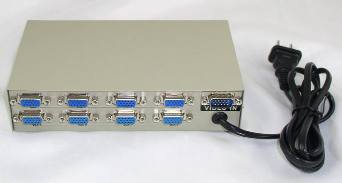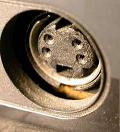The large monitor could be:
- A Large Computer Monitor,
- A Projector,
- A Large TV.
Connecting Several Monitors to a Computer
You can connect several monitors to one computer. You need a video multiplier plus one cable for each monitor. Video multipliers are inexpensive, so be sure to get one that meets your needs.

A Video Multiplier with 8 ports
Factors to consider:
- Number of ports, usually 2, 4 or 8.
- Connections, usually 15 pin VGA
- Transfer Distance -- how long the monitor cables can be. 50m is typical.
- Type of Monitors supported, e.g. VGA, SVGA, XGA, Multi Sync
- Resolution -- Should be as large as that of the video card, and definitely of the monitors to be used.
- Video Bandwidth -- Should be as large as possible, up to the bandwidth of the video card. Determines how fast information can be transferred to the monitors. Video bandwidth is equal to the horizontal resolution times the vertical resolution, times the frames per second that the information on the screen is changed. It is measured in MHz.
- DPMS (VESA Display Power Management Support) -- allows the computer to power down the monitors automatically.
Large Computer Monitors
Images on a computer monitor will usually be of better quality than those on a projector or a TV. The drawbacks are availability and cost.
Flat panel monitors are available in sizes up to 24 inches for a few hundred dollars. Larger monitors are specialty items and command much higher prices.
If a CRT monitor must be chosen, then size and power usage become factors. Thus a 34 inch CRT monitor will weigh 150 pounds, use 500 Watts, and cost around $1400.
Projectors as Computer Monitors
Projectors with resolutions suitable for use with computers are available for as little as $600. Other considerations are:- Lighting sufficient that the room need not be dimmed,
- heat generation,
- noise,
- viewing distance and size of image.
There is also the matter of a screen. This can be a big advantage, if you choose a screen you can write on.
Projector People This website is a buying guide.
TV's as Computer Monitors
Large TV's are much less expensive than large computer monitors, so that it is tempting to use them as a computer monitor. This is often possible. However, TV's are not made to do a computer monitor's job, and a substitution may or may not give satisfactory results.
There are two types of television sets: analog and digital. Most TV's (and all older ones) are analog. Digital TV's are the newer HDTV's. The two types of TV's are so different that they are discussed separately.
Analog TV's
All analog TV's sold in North America are made to the same NTSC (National Television System Committee) standards. They are thus remarkably similar. All have the same vertical resolution, and the same aspect ratio.
On the plus side, the aspect ratio of analog TV's is 4:3. This is the same as most computer monitors. (Aspect ratio is the ratio of screen width to screen height.)
On the minus side, analog TV's have lower resolution than computer monitors, and so the results you get will be poorer. No analog TV, no matter how large, will show as much detail as your computer monitor.
Surprisingly enough, analog TV's often do well with pictures, especially jpeg images. The problems occur with text and with small icons.
Compensating for the Low Resolution of the Analog TV
The vertical resolution of analog TV's is 525. This translates into 480 wavering (or 240 steady) horizontal scan lines. You may have noticed horizontal lines on your television. These are the scan lines. Larger analog TV's do not have more resolution, just thicker scan lines.
To obtain good results, you MUST match the resolution of your computer's graphics card to that of the TV.
The resolution of an analog TV is never more than 640x480. Set the resolution of the computer graphics card to its smallest value.This will increase the size of the text and icons displayed. It will make the display of photographs much more satisfactory.
If text is still too small to be read, the DPI (dots per inch) at which fonts are displayed can be increased. This further increases the size of the text.
Caution: Decreasing the resolution, and increasing the font DPI should be done in small steps. These procedures increase the size of items on your computer screen. This can cause the pages needed to change these parameters to be off screen and unreachable with the mouse. If this happens, they can still be accessed with the TAB and Enter keys, IF you have previously memorized how to do so.
Connecting the Computer to the Analog TV
Analog TV's can be connected to a computer in two ways:
-
 Composite -- Composite video is an analog method for transmitting all video information on one wire.
Composite -- Composite video is an analog method for transmitting all video information on one wire.
-
 S-video is an analog method for transmitting video information on 2 wires. Though it is superior to composite video, it is limited to a resolution of around 500.
S-video is an analog method for transmitting video information on 2 wires. Though it is superior to composite video, it is limited to a resolution of around 500.
First check the television for one of these input jacks. Most analog TV's have a composite input; the newer ones may have S video input.
Next check the computer's graphic card for one of these output jacks.
If the computer's graphic card has an OUTPUT jack which matches an INPUT jack on the TV, only a cable is needed. If not, kits are available which can convert a VGA computer output to S-video or composite.
Overscanning
When you connect the analog TV to your computer, you may find that the edges of the computer screen are missing. This is due to a practice called overscanning. TV's do this on purpose. They only show the central 90% of the picture.
The cure is to use the afore-mentioned computer to TV kit. These allow correction for overscanning.
Digital TV's
Digital TV's are often planned for computer input. When this is so, they give good results with the display of text. However this does not mean that the entire screen, is available for computer input. For example, my 50 inch TV becomes a 34 inch (or less) computer monitor.
To find out how much of the screen is usable, you must check the manual to find which graphics card outputs can be used with that TV. These will be less than the rated pixels of the TV.
Digital TV's can be connected using composite or S video cables, but to do so would be wasteful. These cables are not capable of transmitting the large amount of data which can be handled by a digital TV. If you connect a digital TV using an S video or composite cable, you will get the same results you would expect with an analog TV. You should use the recommended computer input on the TV.
LCD and Plasma TV's have more stringent viewing angle requirements than CRT TV's. This should be taken into consideration in placement of the TV.